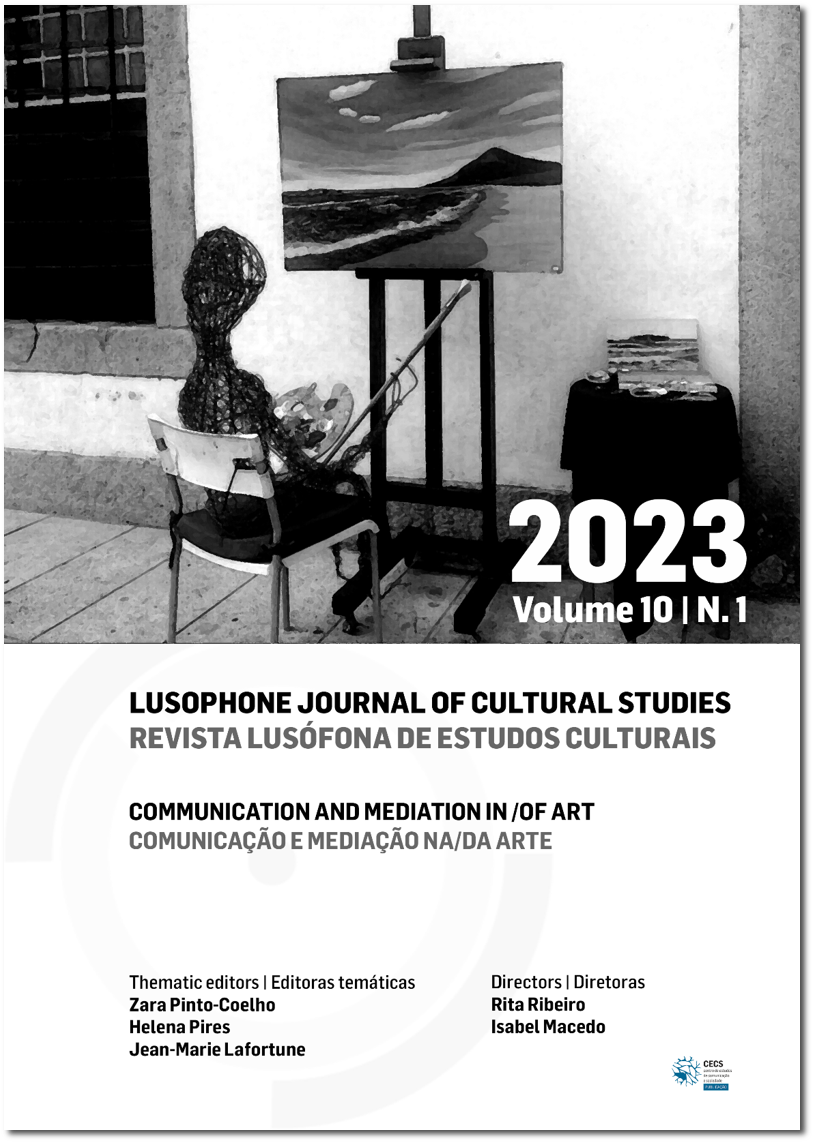Interactions Between the Gramado Film Festival Museum, the Film Festival and the Local Cultural Tourism
DOI:
https://doi.org/10.21814/rlec.4216Keywords:
Gramado Film Festival Museum, 1930s, cultural tourismAbstract
This study is part of the theoretical field of cultural studies and chooses as its object of analysis the Gramado Film Festival Museum and its links with the Film Festival and local cultural tourism. The main goal is to reflect on the museum as a hybrid cultural producer, which triggers, through interactivity, representations of the Film Festival and the city of Gramado itself, producing multiple meanings among its visitors and boosting local cultural tourism. In this sense, some questions are pivotal to this study: what representational strategies are used in the permanent exhibition at the Gramado Film Festival Museum? What cultural representations does the museum communicate about the Film Festival and the city of Gramado? As a methodology, we used the ethnographic observation of the museum's permanent exhibition with records in a field diary. Among the contingent and provisional findings, under the aegis of postmodern cultural convergence, the modulation of culture and art in the museum's permanent exhibition stands out, producing multiple connections between the Film Festival, the museum and cultural tourism in the city from Gramado.
Downloads
References
Anico, M. (2005). A pós-modernização da cultura: Património e museus na contemporaneidade. Horizontes Antropológicos, 11(23), 71–86. https://doi.org/10.1590/S0104-71832005000100005
Brito, Z., & Araújo, B. (2022). SEDAC. In Gramadotur (Ed.), Catálogo do 50º Festival de Cinema de Gramado (p. 17). Ministério do Turismo e Claro. http://gemelo.me/wp-content/uploads/2022/08/catalogo_50_web.pdf
Canclini, N. G. (Ed.). (1993). El consumo cultural em México. CNCA.
Canclini, N. G. (2006). Culturas hibridas: Estratégias para entrar e sair da modernidade (H. P. Cintrão & A. R. Lessa, Trads.). EDUSP. (Trabalho original publicado em 1990)
“Cerimônia oficializa Kikito como patrimônio cultural de Gramado”. (2022, 11 de novembro). Câmara Municial de Gramado. https://gramado.rs.leg.br/noticia/visualizar/id/9763/?cerimonia-oficializa-kikito-como-patrimonio-cultural-de-gramado.html
Chagas, M. S. (2006). Há uma gota de sangue em cada museu: A ótica museológica de Mário de Andrade. Argos.
Coffey, A. (1999). The ethnographic self: Fieldwork and the representation of identity. Sage.
Daros, M. (2008). Grãos: Coletânea histórica. Palotti.
Hall, S. (2013). Quem precisa de identidade. In T. T. Silva (Ed.), Identidade e diferença: A perspectiva dos estudos culturais (pp. 103–112). Vozes.
Hall, S. (2016). Cultura e representação (D. Miranda & W. Oliveira, Trads.). Apicuri. (Trabalho original publicado em 2013)
Hewison, R. (1999). The climate of decline. In D. Boswell & J. Evans (Eds.), Representing the nation: A reader: histories, heritage and museums (pp. 151–162). Routledge.
Hudson, K. (1999). Attempts to define “museum”. In D. Boswell & J. Evans, (Eds.), Representing the nation: A reader: Histories, heritage and museums (pp. 371–379). Routledge.
Jenkins, H. (2009). Cultura da convergência (S. Alexandria, Trad.). Aleph. (Trabalho original publicado em 2006).
Jenkins, H. (2015). Cultura da conexão: Criando valor e significado por meio da mídia propagável (P. Arnaud, Trad.). Aleph.
Lasanski, D. M. (2004). Introduction. In D. M. Lasanski & B. McLaren (Eds.), Architecture and tourism: Perception, performance and place (pp. 1–14). Berg.
Lei 1738/00 | Lei nº 1738 de 15 de junho de 2000. (2000). http://camara-municipal-do-gramado.jusbrasil.com.br/legislacao/407485/lei-1738-00
Lumley, R. (Ed.). (1988). The museum time-machine. Routledge.
Lupo, B. (2021). Interatividade no espaço expositivo: Os casos do Museu do Futebol e do
Museu do Amanhã. In A. Castro, C. Almeida, F. Brito, J. Lira, L. Leão, T. Maretti, & F. Paiva (Eds.), Anais do 1º Seminário de História e Fundamentos da Arquitetura e Urbanismo (pp. 399–412). FAU/USP.
Machado, L., & Zubaran, M. A. (2013). Representações racializadas dos negros nos museus: O que se diz e o que se ensina. In J. R. Mattos (Ed.), Museus e africanidades (pp. 137–156). Adijuc.
Projeto de Lei do Executivo - PLE 042.15. (2015).
https://gramado.rs.leg.br/materia/visualizar/id/3717/?ple-04215.html
Projeto de Lei do Legislativo n.º 028/2022. (2022). https://gramado.ecbsistemas.com/view.php?id=33512&md5=f62f5f52e3f2eb84a47585136b43e6a2
Quintans, D. (2008). 35 anos do Festival de Cinema: Memória cultural. ACTG.
Rojek, C., & Urry, J. (1997). Touring cultures: Transformations of travel and theory. Routledge.
Sebrae. (2022, 16 de agosto). Festival de Cinema de Gramado tem grande potencial turístico. https://www.sebrae.com.br/sites/PortalSebrae/artigos/festival-de-cinema-de-gramado-tem-grande-potencial-turistico,3c4b2b52ad952810VgnVCM100000d701210aRCRD#:~:text=O%20Festival%20de%20Gramado%20tamb%C3%A9m,criativa%20ligada%20%C3%A0%20produ%C3%A7%C3%A3o%20audiovisual
Secretaria Municipal de Educação de Gramado. (1987). Gramado, simplesmente Gramado. Secretaria Municipal de Educação de Gramado.
Silva, T. T. (2010). Documentos de identidade: Uma introdução às teorias do currículo. Autêntica.
Souza, S. J., & Lopes, A. E. (2002). Fotografar e narrar: A produção do conhecimento no contexto da escola. Cadernos de Pesquisa, (116), 61–80. https://doi.org/10.1590/S0100-15742002000200004
Steinberg, S. R. (2016). Produzindo múltiplos sentidos – Pesquisa com bricolagem e pedagogias culturais. In K. Saraiva & F. Marcello (Eds.), Estudos culturais e educação: Desafios atuais (pp. 211–243). Editora Ulbra.
Steinberg, S. R., & Kincheloe, J. (Eds.). (2004). Cultura infantil: A construção corporativa da infância (2.ª ed.; G. E. J. Bricio, Trad.). Civilização Brasileira. (Trabalho original publicado em 1997).
Urry, J. (2001). O olhar do turista: Lazer e viagens nas sociedades contemporâneas (3.ª ed.). Studio Nobel.
Wortmann, M. L. C., Costa, M. V., & Silveira, R. M. H. (2015). Sobre a emergência e a expansão dos estudos culturais em educação no Brasil. Educação, 38(1), 32–48. https://doi.org/10.15448/1981-2582.2015.1.18441
Downloads
Published
How to Cite
Issue
Section
License
Copyright (c) 2023 Manoela Barbacovi, Maria Angélica Zubaran

This work is licensed under a Creative Commons Attribution 4.0 International License.
Authors own the copyright, providing the journal with the right of first publication. The work is licensed under a Creative Commons - Atribuição 4.0 Internacional License.












